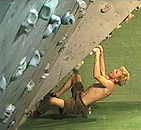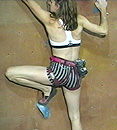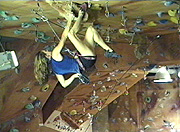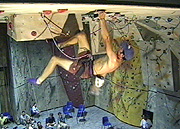Sponsored By
ROCK
HARDWARE
| For All Your Climbing Gear! |
 Climbing
Media
Reviewed
Climbing
Media
Reviewed
[ Books | Movies | Screen Shots | Best Stuff | Aussie Titles | Latest Reviews | Reviewed Only | All ]
Moving Over Plastic
(Doco) Improve climbing performance through indoor climbing
| Format |
Video
|
Category | Instructional |
| Title | Moving Over Plastic | Mins | 50 |
| Starring | Garth Miller, Bobbi Bensman, Catherine Destivelle, Malcolm Matheson, Christina Bedard, Mark Baker | RRP | |
| Director | Mark Baker, Lactic Productions | Reviews | 2 |
| Edition | 1998 | Ave Rating |
| User | Comments |
|
Mike 8/27/2002 |
Moving Over Plastic, as the title suggests is a video about improving your gym climbing skills. It’s focus is on beginner gym climbers who have already come to terms with the absolute basic concepts of body movements, hand grips, and so on, and now want to expand their repertoire of techniques and improve their performance. Concentrated on the gym scene, it may not appeal to all, however there are a few outdoor routes shown, and the interviews with big name climbers add considerable value. At least the video-photography and post-production editing is quality stuff, obviously done by a professional. Also of note for locals, is that this is an Australian film, which includes a lot of content from some of our best climbers of today, like Garth Miller and Malcom Matheson. Let’s face it, even hard core climbers could still take advice from someone who onsights grade 32.  Above: Garth Miller. The movie opens with an 8-minute segment introducing the main players. The Aussies: Garth Miller – One of only two people in the world to have onsighted grade 32. Malcom Matheson – Established many of Australia’s hardest routes. Christina Bedard – Won many Australian comps, onsighted grade 25. Mark Baker – An instructor. Also won many Australian comps, and established numerous hard routes. International: Bobbi Bensman – One of the best female sport climbers in the US. Catherine Destivelie – From France. First women to climb grade 29, soloed the North Face of the Eiger in 16 hours. Next is a discussion on gender differences. Bobbi says men are stronger and taller, but women are lighter and more flexible so there is really not much separating them. We see shots from Escalade 97, and Robert LeBreton and Saxon Johns competing at “The Pitch” in 98. The topic of technique is covered next, and occupies the bulk of the movie. Garth talks about flow, linking moves, and efficiency. Malcom on using minimum energy, balance and weight transfer. Mark breaks technique into contact and movement. Under contact we are told about pockets, slopers, open hand vs crimp, footwork, inside vs outside edge, heel hooks, knee bars, footwear, comfort vs performance, slippers vs stiffer soles, warming up, stretching, flexibility, range of movement, etc. It’s worth noting though that actual handgrips and body movements are not really explained, just a selection shown fairly quickly. This is, after all, about improving performance, not the basics of how to climb, which it is assumed you already know. Under movement technique, we are shown some footwork that may have escaped the beginner, such as back stepping, matching, rocking on, and flagging (inward, behind and side).   A couple of minutes on routes setting, and trying to read what the route setter intended is followed by a discussion on having goals. Garth and Bobbi explain their goals, both short and long term. The footage of Malcom aid soling Ozymandias, and Lord Gum Tree at Mt Buffalo is tantalising. I would have liked to have seen more of this. Mental aspects are the next topic. We see Mark on “See Air” a grade 28 in the Blue Mountains. He pops a cool dyno. Garth on “Better Than Life”, grade 31 is inspiring. This outdoor footage makes the film more watchable for climbers not really interested in the gym scene. Lastly we are given some general advice from each cast member. Garth tells us to keep our heels low and climb slow until the crux, then “run”. Christina (photogenic to say the least), suggests exaggerating movements until they become instinctual. Mark says not to train too hard to avoid finger and shoulder injuries, and Malcom expresses the view that it’s all in the attitude, obtaining a diversity of techniques and building power and endurance.   The film takes us to many of the gyms around Australia, showing footage from competitions, including comps at The Pitch in 98, Escalade 97 and Cliff Hanger Nationals 96. As the credits role, we are shown speed climbers from the 1998 Extreme Games in Queensland. In summary, this video is worth watching if you’re looking for a little inspiration, and some tips on improving your climbing technique, with focus mainly in the gym. It doesn’t discuss system training, anything like that. (If you’re into training, I suggest a good book, such as Flash Training). The movie has been done professionally, and does not show any sign of amateur camera work or editing. The only downer might be that it may only appeal to a limited audience, primarily newish gym climbers looking to push their grades. On the other hand, as I said in the first paragraph, even hard core climbers could still take advice from someone who onsights grade 32. |
|
Drew 8/14/2002 |
An average instructional video for the beginner, with some great footage of competition climbing. The various climbers talk about technique and training as it relates to them, some of the movement technique is very good for those just starting out. If you want to see the video, Y-Rock has a copy that you can watch there. Drew |
Further Reading:
Climbing Australia - Details on purchasing, etc.
Home | Guide | Gallery | Tech Tips | Articles | Reviews | Dictionary | Forum | Links | About | Search
Chockstone Photography | Landscape Photography Australia | Australian Landscape Photography
Please read the full disclaimer before using any information contained on these pages.
All text, images and video on this site are copyright. Unauthorised use is strictly prohibited.
